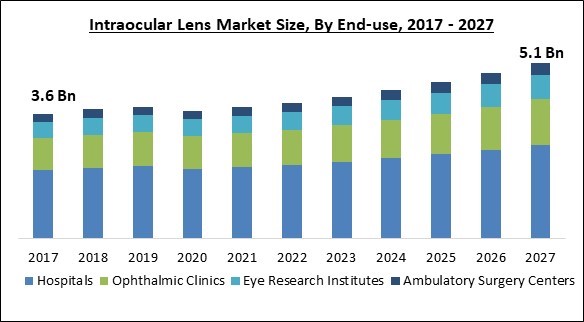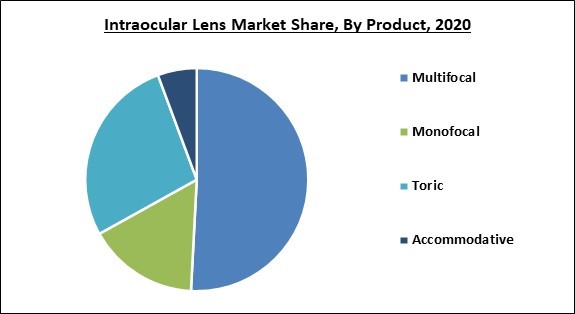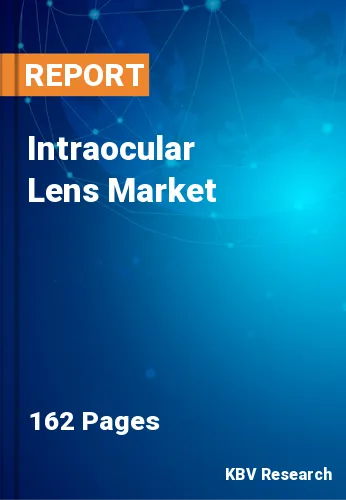The Global Intraocular Lens Market size is expected to reach $5.1 billion by 2027, rising at a market growth of 5.0% CAGR during the forecast period.
An intraocular lens is an artificial lens that is implanted in the eye during cataract surgery to replace the natural lens. The worldwide intraocular lens market is predicted to develop as the senior population becomes more sensitive to ocular disorders, cataract prevalence rises, and government measures to eradicate avoidable blindness increase. Furthermore, the market's growth is aided by an increase in the usage of premium lenses, which provide benefits such as improved visual performance and decreased astigmatism. However, the market is projected to be hampered by an unfavorable reimbursement environment for premium lenses, as well as postoperative problems such as refractive errors.
The front face of traditional intraocular lenses is consistently curved from the lens's centre to its perimeter, resulting in a spherical optical design. However a spherical IOL is simple to make, it does not replicate the form of the natural lens within the eye, which has a varying curvature from centre to periphery. In other words, the normal lens of the eye is aspheric ("not spherical"). Higher-order aberrations (HOAs) are tiny optical flaws caused by a spherical intraocular lens that can impact vision quality, especially in low-light situations like driving at night.
The growing number of geriatric and diabetic people, who are more likely to acquire cataracts and other vision problems, is predicted to boost market development. Furthermore, growing awareness of visual impairments, increased healthcare expenditure, and government assistance to develop healthcare infrastructure are among the major drivers driving market expansion.

Routine healthcare visits were cancelled as a result of the COVID-19 outbreak in December 2019, in order to prevent people from catching the virus. In the first half of 2020, this had a negative influence on the market. There was a considerable decline in procedure volumes since many patients were older and at a higher risk of developing COVID-19 symptoms, resulting in revenue loss and the temporary or permanent shutdown of single ophthalmic practise units.
Nevertheless, as a consequence of the reopening of several medical institutions and practises in the later part of 2020, patients volumes increased. Furthermore, the use of modified face-to-face visits and telecommunication permitted for the continuation of a modest number of surgeries throughout the pandemic's height. However, certain operations, such as cataract surgery, are still experiencing a backlog.
Low vision and blindness are major global public health issues that are becoming more common as a result of demographic shifts and ageing populations. The number and proportion of persons above the age of 65 is increasing. Vision loss is common among the elderly, and it has a negative impact on their quality of life. Losing one's ability to see is a life-changing event for those who are impacted and their family. But that's not all: being the most severe ocular problem consequence, blindness indicates a lot about the population's overall disease burden. As a result, the occurrence of blindness and visual impairment is a good indication of overall health.
The segment's dominance in refractive surgery assessment can be attributed to a rising need to meet the growing number of patients of uncorrected refraction and corneal opacity across the world. Furthermore, cataract surgery is becoming more widely accepted as the best option for recovering eyesight in persons with cataracts. According to World Health Organization (WHO) predictions for 2019, about 123.7 million individuals have visual loss due to uncorrected refractive error, 65.2 million people have cataracts, 6.9 million people have glaucoma, and 4.2 million people have corneal opacity. The Cataract Surgery assessment sector, on the other hand, is estimated to develop the quickest over the forecast period due to growing usage of corneal topographers in the sector due to technological improvements that boost market demand.
A World Health Organization examination of 1.5 million individuals that year revealed that around 9 million people were blind, with cataract causing 4 million cases of blindness. In comparison to other medical fields, ophthalmology relies more on specialized equipment and knowledge, and a dearth of both has resulted in a substantial unmet need for eye care centers in the 1.2 billion-strong country. Governments are undertaking measures to improve eye health, but insufficient eye care services and limited funding have hampered plans.

Based on End-use, the market is segmented into Hospitals, Ophthalmic Clinics, Eye Research Institutes, and Ambulatory Surgery Centers. Because the majority of cataract and vision correction procedures are conducted in hospitals, the hospitals sector led the market in 2021. Individual ophthalmic clinics are increasing in number in developing countries. There are no hospitals associated with these clinics. The rivalry among service providers is projected to heat up as the number of eye care practitioners and clinics grows. The provision of treatments at low pricing is likely to boost the number of people choosing these clinics for treatment, fuelling segment expansion.
Based on Product, the market is segmented into Multifocal, Monofocal, Toric, and Accommodative. The toric intraocular lens sector, which is advantageous primarily for patients with moderate to high astigmatism, was the second-largest segment in 2021 and is predicted to rise at a profitable pace throughout the projection period. Astigmatism causes myopia, hypermetropia, or both in patients. Toric intraocular lenses are made particularly for such people. Furthermore, toric IOLs are meant to minimize the necessity for incision implants, which were previously necessary during astigmatism surgical operations, enhancing their popularity among people.
| Report Attribute | Details |
|---|---|
| Market size value in 2020 | USD 3.7 Billion |
| Market size forecast in 2027 | USD 5.1 Billion |
| Base Year | 2020 |
| Historical Period | 2017 to 2019 |
| Forecast Period | 2021 to 2027 |
| Revenue Growth Rate | CAGR of 5% from 2021 to 2027 |
| Number of Pages | 162 |
| Number of Tables | 280 |
| Report coverage | Market Trends, Revenue Estimation and Forecast, Segmentation Analysis, Regional and Country Breakdown, Companies Strategic Developments, Company Profiling |
| Segments covered | Product, End-use, Region |
| Country scope | US, Canada, Mexico, Germany, UK, France, Russia, Spain, Italy, China, Japan, India, South Korea, Singapore, Malaysia, Brazil, Argentina, UAE, Saudi Arabia, South Africa, Nigeria |
| Growth Drivers |
|
| Restraints |
|
Based on Regions, the market is segmented into North America, Europe, Asia Pacific, and Latin America, Middle East & Africa. Asia Pacific is predicted to expand at the quickest rate. The existence of a high elderly and diabetic population, both of whom are susceptible to cataracts and other ocular illnesses, is driving the market in this area. Furthermore, the market is growing due to increased knowledge of improved treatment alternatives and an inflow of people from wealthy nations seeking cheap healthcare.
Free Valuable Insights: Global Intraocular Lens Market size to reach USD 5.1 Billion by 2027
The market research report covers the analysis of key stake holders of the market. Key companies profiled in the report include EyeKon Medical, Inc., Lenstec, Inc., HumanOptics AG, STAAR Surgical Company, Rayner Intraocular Lenses Limited, Bausch Health Companies, Inc., Carl Zeiss AG, Johnson & Johnson (Johnson & Johnson Vision Care, Inc.), Hoya Corporation, and Alcon, Inc.
By End-Use
By Product
By Geography
The intraocular lens market size is projected to reach USD 5.1 billion by 2027.
Eye disorders and vision impairment are becoming more common are driving the market in coming years, however, trained ophthalmology surgeons are in short availability limited the growth of the market.
EyeKon Medical, Inc., Lenstec, Inc., HumanOptics AG, STAAR Surgical Company, Rayner Intraocular Lenses Limited, Bausch Health Companies, Inc., Carl Zeiss AG, Johnson & Johnson (Johnson & Johnson Vision Care, Inc.), Hoya Corporation, and Alcon, Inc.
The Ophthalmic Clinics has shown high growth rate of CAGR of 5.2% during (2021 - 2027).
The North America is fastest growing region in the Global Intraocular Lens Market by Region in 2020, and would continue to be a dominant market till 2027.
Our team of dedicated experts can provide you with attractive expansion opportunities for your business.

